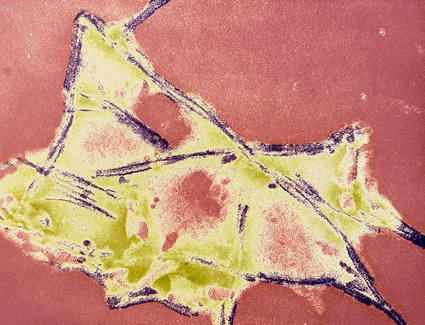Nano-Sized Sensor Detects Prion Proteins
By Labmedica staff writers
Posted on 03 Mar 2008
Posted on 03 Mar 2008

Image: False-color transmission electron micrograph (TEM) of fibrils in an extract of fresh brain from a cow infected with Bovine spongiform encephalopathy (BSE) (Photo courtesy of EM Unit, CVL, Weybridge).
Prions are infectious proteins that are believed to cause deadly nerve-damaging diseases such as mad cow disease in cattle, scrapie in sheep, and a human form of mad cow disease called variant Creutzfeldt-Jakob disease. Conventional tests are designed to detect the proteins only upon autopsy, and the tests are time-consuming and unreliable.
In a new study, Harold G. Craighead, Ph.D., from Cornell University (Ithaca, NY, USA) and colleagues described a high-tech, nano-sized device called a nanomechanical resonator array. The device includes a silicon sensor, which resembles a tiny tuning fork, which changes vibrational resonant frequency when prions bind. Its vibration patterns are then measured by a special detector.
The detection system was based on arrayed resonant sensors using secondary mass labeling. With the use of antibodies as secondary mass labels 2 µg/ml concentrations of prion protein (PrP) were detected, while the addition of nanoparticle mass labels improved the detection limit by three orders of magnitude to 2 ng/mL. Owing to the high sensitivity of resonator-based detection systems, the investigators of the study claimed that they could be suitably applied to develop antemortem tests to directly detect PrP in body fluids.
The study appeared online in the February 2008 issue of the American Chemical Society's journal Analytical Chemistry.
Related Links:
Cornell University














